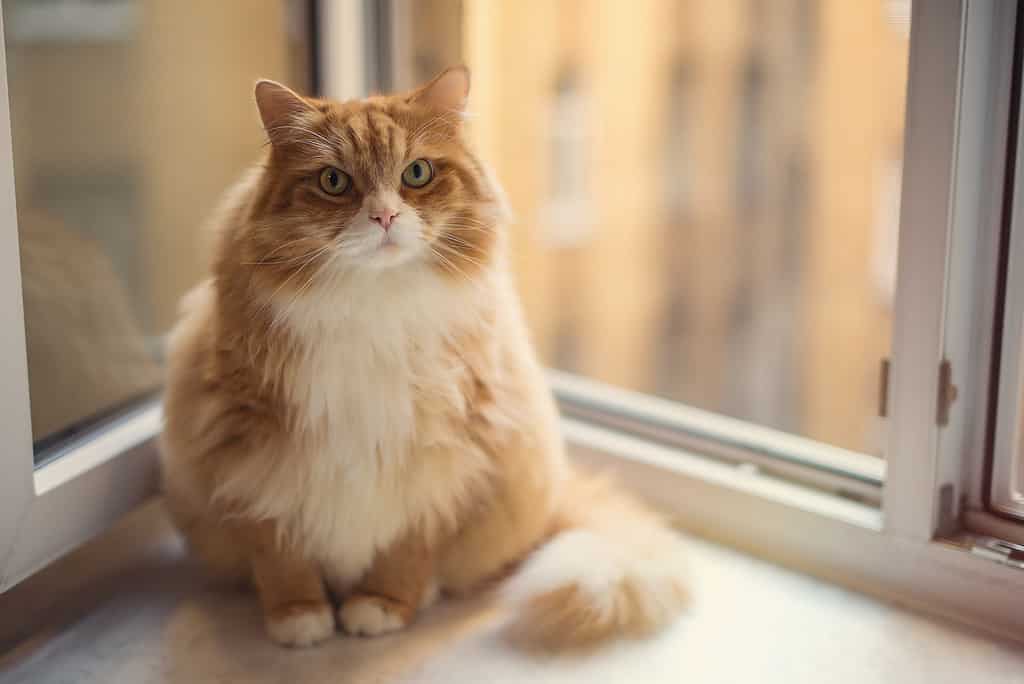It’s far too common a condition in cats and it’s one you’re in control of. Almost 60% of all domesticated cats are in the obese category. But what does this mean, exactly? And what can you do about it to help your feline friend live a longer, healthier life? Let’s explore obesity in cats, including risks and tips for helping your cat shed excess weight!
Obesity in Cats Defined
Your cat may be looking a little extra chunky these days, but is it obesity? Well, that depends. The generally accepted measure is that if a cat is 20% or more above its normal, expected weight, it is in the obese category. The good news about obesity is that the clinical signs aren’t difficult to detect. You can clearly see — and feel — when your cat is fatter than usual.
When your cat is obese, its quality of life tanks. You notice that instead of actively playing and exercising, your cat is more sluggish, resting more often than usual. Often, obese cats struggle with keeping themselves clean as well, as they have a harder time reaching their hindquarters. But these are only some of the difficulties that arise when cats are obese.

Obese cats may have trouble grooming themselves, especially when they try to access hard-to-reach places like their hindquarters.
©Konstantin Aksenov/iStock via Getty Images
Obesity Risks
When a cat is dealing with severe obesity, other disorders often develop. Dr. Colleen Wallace, a cat-only vet at Cozy Cat Veterinary Hospital in Raleigh, NC told A-Z-Animals, “[Obesity] can contribute to the development of arthritis as the joints (especially the elbow and knees) are stressed from the cat jumping up and down from furniture, etc. Also, because fat is an inflammatory tissue, and contributes to the development of inflammation not only in the joints, but also in any of the other major organs as well. Lastly, it vastly increases the risk of the cat becoming diabetic over time.”
Along with diabetes and arthritis, osteoarthritis is a condition that occurs when the cartilage starts eroding and bones start rubbing together, which creates an awfully painful sensation during movement.
Another condition that may develop in obese cats is hip dysplasia. Often, this is a genetic condition a cat may inherit but extra weight only exacerbates it. Hip dysplasia is when a cat’s thigh bone and hip bone don’t connect how they’re supposed to. It’s an incurable condition that can be managed in some cases but may require surgery if severe.
Obesity puts your cat at risk for several issues and impacts cardiovascular health. When osteoarthritis or hip dysplasia occurs, your cat’s movement is limited. With limited mobility, you can’t encourage exercise. Without proper exercise, weight gain is possible. Though weight loss is possible via changes to diet, it’s better if you work to prevent any other condition from developing by keeping your cat at a healthy weight.
Is Your Cat Obese?

Obese cats are at risk of developing other health conditions, such as osteoarthritis.
©Myskina6/iStock via Getty Images
You should be able to see your cat’s waist when it’s within a normal weight range. When your cat is obese, you may notice that its belly bulges out just behind where its ribs are. When you touch your cat’s rib area and you can’t feel its ribs, it’s holding on to more fat than it needs to.
An obese cat has more of a rounded belly, and it may even sag. Along with not being able to feel their ribs, you may also have trouble feeling their backbone, as it may be hiding behind fat layers. Your veterinarian can confirm whether your cat is obese, but you can also monitor your cat’s weight by using your own scale at home.
Weigh yourself first, then hold your cat and weigh yourself again. This difference is what your cat’s weight is. If you’re working on helping your cat lose excess pounds, this is a helpful way to keep track to ensure progress and make alterations as needed.
How to Help Your Cat Lose Weight
Don’t embark on this journey with your cat alone. Consult your veterinarian to develop a suitable weight-reduction plan for your kitty. Progress should be slow and intentional. If you make a change that is too drastic, like severely limiting your cat’s food, this is a starvation diet. When your cat is shocked by a sudden lack of food availability, it may develop hepatic lipidosis, which is a severe condition.
Opt instead to be gradual with your cat’s weight loss. The ideal weight loss rate should be anywhere between 1% and 2% of body weight loss each week. Your veterinarian can help you determine your cat’s daily caloric needs, so you can measure out any dry kibble or wet food. Avoid free-feeding with obese cats.
Additionally, you can encourage physical activity. Nothing too strenuous at first. Just try incorporating some play during the day. As your cat starts shedding the excess weight, it’ll feel more comfortable and may get more playful. Play and exercise along the way can help your cat reach and maintain a healthy weight long-term.
The photo featured at the top of this post is © Koldunov Alexey/Shutterstock.com
Thank you for reading! Have some feedback for us? Contact the AZ Animals editorial team.







